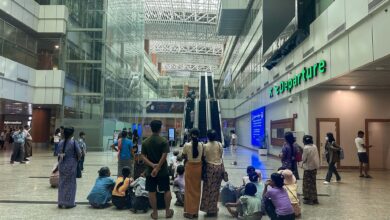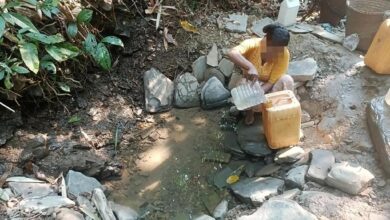
The morning of January 7 in the Tamu Township village of Kanan was like any other busy Sunday, with people getting ready to attend church, children playing football on the sports grounds, and their family members watching from the sidelines.
At 10:30, the bustle of the northwestern Sagaing Region community was interrupted by the unmistakable rush of a jet overhead, followed by explosions, five minutes apart.
The bombs dropped from the aircraft hit Kanan’s high school, next to St Peter’s Church, just before the start of the next worship service.
“It was a moment when people were either returning from or heading to church,” a Kanan resident explained. “We suddenly heard the sound of a plane, followed by the sound of bombs. Some villagers ran, and some hid. Then the plane dropped another bomb next to the church.”
Because of this timing, the casualties were particularly high; 17 people were killed—12 men, five women, and nine children.
Their bodies were found in residences on the street west of the church and near the football field, another local man said, remembering that he had been getting ready to head to the church himself when he heard the blasts.
“The bodies of two people playing football were found on the school grounds. Three were found in an apartment, and another body was found in a wooden house. A body was also found under a tamarind tree,” he recalled. “They were hiding because they felt fear. They had run away from the church.”
Video footage captured by residents and seen by Myanmar Now showed people fleeing as the plane flew overhead after the first airstrike—a second attack followed, with smoke billowing from the bombsite. Two women were seen in another clip, lying in the street, their legs nearly severed, covered in blood.
Two of the victims were dismembered and their bodies unrecognisable, identified by rescue operation volunteers only after consulting with other Kanan locals.
“The two bodies were disfigured, with only the soles of their feet, fingers, and intestines found. We had to retrieve what we could,” one of the individuals involved in the rescue efforts said. “We consulted with family members to identify the possibilities of who they were, and examined the nearby deceased bodies, and dispatched villagers to confirm the gender and identity of the persons.”
All of those who died were buried together in a mass grave that evening.
Of the 19 people who were injured in the bombings, most—11—were children under the age of 17 who had been playing football at the time of the attack.
“The children attended Sunday school at around 7:30 in the morning. Afterwards, they would play football until lunch,” a resident said. “Some were watching their siblings play… the children on the sports grounds were affected by the airstrikes.”
Unable to travel to larger regional towns like Kalay—50 miles south—due to military restrictions on road travel, those who were injured were limited to the treatment available in local clinics, where there are known shortages of sterile supplies and medicine.
“The military council did not allow the wounded to enter the town [of Kalay],” Yati Ohn, in charge of a local mobile medical team, said in a January 12 press conference held by the publicly mandated National Unity Government (NUG). “The junta casually inspected private clinics and hospitals in the town, fearing that patients from the airstrike might enter secretly. Hospitals are not allowed to treat any patient from Kanan. No vehicles are allowed to pass.”
In total, the high school building, St Peter’s Church and around eight houses were destroyed in the blasts, “reduced to mere skeletons,” according to a spokesperson from a local resistance force, the Upper Chindwin Chapter of the Chin National Organisation.
“The bombs were very powerful,” he said. “I can’t emphasise how forceful it was. Though they didn’t directly hit the houses, only the pillars—like bones—remained.”
Denial of the attack
Located on the India-Myanmar Friendship Highway, the residents of Kanan are from the ethnic Mizo Chin and Kuki communities, and largely Christian. Local sources said that St Peter’s Church was attended by the village’s Chin residents, and most of the victims were from this population. However, some of the homes which were destroyed in the bombings belonged to Kuki families.
The village is situated across a bridge from the border town of Khampat, which came under the control of the NUG after resistance forces seized it in November. It is around 30 miles from Tamu Township’s administrative centre, which remains under junta rule.
Map showing the location of the airstrike and neighbouring towns (Myanmar Now)
While there were no clashes around Kanan immediately preceding the January 7 airstrike, rumours have circulated suggesting that the military was acting on a tip that the NUG’s local People’s Defence Team had been scheduled to carry out a training graduation ceremony in the area that day, but Myanmar Now was unable to independently verify this information.
The military council rarely discloses information regarding its forces’ activities, and in a statement issued hours after the airstrike on Kanan, they dismissed the reports of the attack as false.
“It is learnt that there was no flight this morning, and the information that the military bombed the village was misinformation,” it said.
A man from Kanan dismissed the statement as false.
“No one else possesses fighter planes in Myanmar except for the military,” he said. “It is impossible that they wouldn’t be responsible for the airstrikes. Several thousand people saw those planes.”
In the nearly three years since the February 2021 military coup, the junta has carried out more than 580 airstrikes targeting civilian areas, killing nearly 900 people, according to figures published by the NUG this month. Some 76 religious buildings and 52 schools have also been damaged in these aerial attacks.
The deadliest bombardment during this time occurred last year in Sagaing Region, when the military carried out an April airstrike on Pazigyi village in Kanbalu Township, killing more than 150 people.



